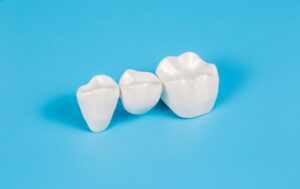 Have you lost several teeth in a row in one or both of your arches? If so, you might be an ideal candidate for a dental bridge. These restorations contain the correct number of pontics (artificial teeth) with a dental crown on each side that anchors to healthy abutment teeth or dental implants in your mouth. This single oral appliance can simultaneously boost your smile’s appearance and functionality.
Have you lost several teeth in a row in one or both of your arches? If so, you might be an ideal candidate for a dental bridge. These restorations contain the correct number of pontics (artificial teeth) with a dental crown on each side that anchors to healthy abutment teeth or dental implants in your mouth. This single oral appliance can simultaneously boost your smile’s appearance and functionality.
Although these prosthetics can potentially last 15+ years if cared for correctly, they’re not impervious to harm. Continue reading to learn about 3 factors that could cause your dental bridge to fail so you can avoid them!
Culprit #1: Poor Dental Hygiene
Your new restoration is made of a resilient tooth-colored material like porcelain or resin that can’t get cavities. However, that doesn’t mean you can quit your at-home dental hygiene routine. Traditional bridges rely on the natural teeth on either side of the space in your smile to remain firmly bonded in place. If these develop cavities or gum disease, it could cause the attachment to become loose or fall off altogether.
To keep your grin happy and healthy, brush and floss twice daily. Also, visiting your dentist every 6 months for a routine checkup and cleaning allows them to monitor your condition and treat any areas of concern, like thinning enamel, before they progress into real problems.
Culprit #2: Bad Habits
If you anxiously nibble pen caps or fingernails when you feel nervous, it’s a good time to find alternative coping mechanisms. Your teeth are meant to bite into and chew food, not inanimate objects. Crunching down on overly hard items or ingredients can potentially chip or crack your artificial teeth.
Also, smoking tobacco products and drinking alcohol can suppress your body’s ability to deliver nourishment to your mouth that’s needed to fight germs. Indulging in these unhealthy habits can negatively affect your gum health and destabilize your restoration.
Culprit #3: Insufficient Bone Support
Did you know that tooth loss causes your jawbone to thin? Without a root in place to stimulate new bone growth when you bite down, it starts to erode. Unfortunately, losing multiple teeth only exacerbates this process of degeneration. Eventually, your jaw can grow too frail to continue providing a firm foundation for your teeth.
Sometimes, an implant bridge can be placed to prevent this process. This procedure involves surgically placing a dental implant on each side of the gap in your grin to function as the abutment that anchors your prosthetic.
Now that you know some common risks to your dental bridge, you can make conscientious choices to preserve your restoration in the long run!
About the Author
Dr. Julie Young has 23+ years of experience helping people of all ages enhance their lives by improving their dental condition. She is an active member of the American Dental Association and several other prestigious organizations, so you can trust that you’re in good hands. She and her team are dedicated to delivering top-quality services with care and enthusiasm to put patient comfort first. Then, she utilizes state-of-the-art equipment to deliver personalized treatments for accurate results. If you need help replacing missing teeth, you can request a consultation on the website or call (415) 924-5300.
